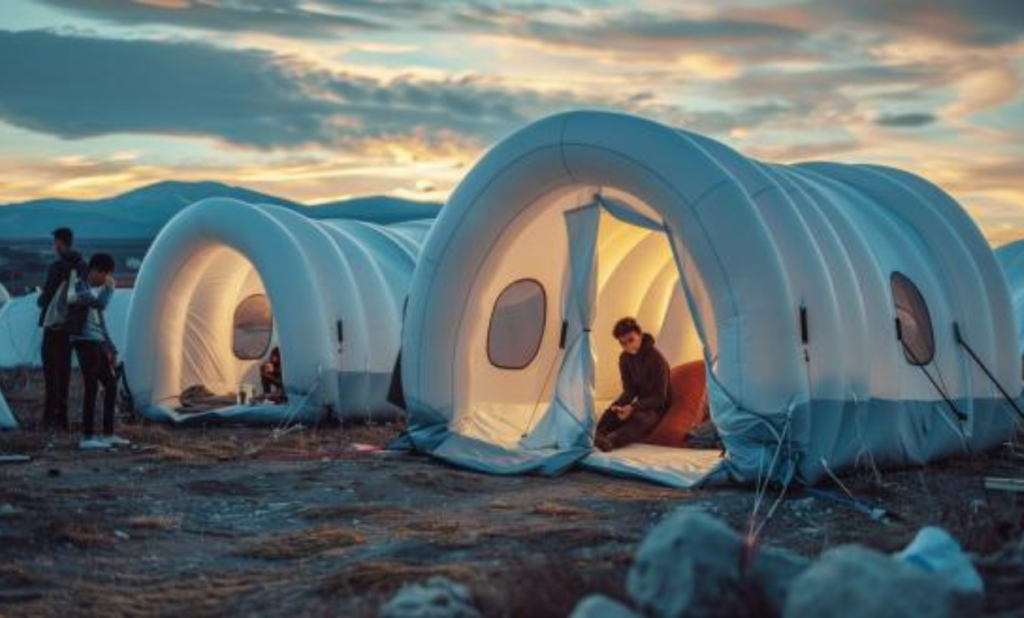Imagine the feeling of waking up to the gentle rustling of leaves and the soft rays of the sun filtering through the trees. The fresh scent of nature fills your lungs, and a sense of tranquility washes over you. It’s a moment of pure bliss, where you can escape the demands of everyday life and immerse yourself in the beauty of the great outdoors.
For those who love camping, this experience is not just a dream but a reality. And if you’re considering camping with an inflatable tent, you’re in for a treat. These innovative tents have revolutionized the camping industry, offering convenience, durability, and ease of setup like never before.
But before you embark on your camping adventure with an inflatable tent, it’s important to familiarize yourself with the rules and guidelines that govern camping with these tents. Understanding the regulations ensures not only your safety but also the preservation of nature and the enjoyment of fellow campers.
In this article, we will delve into the camping rules for inflatable tents, providing you with all the information you need to have a safe and memorable camping trip. From inflatable tent guidelines to safety regulations, we’ve got you covered. So let’s dive in and explore the world of camping with inflatable tents!
Key Takeaways:
- Familiarize yourself with the camping regulations for inflatable tents to ensure your safety and the enjoyment of fellow campers.
- Inflatable tents provide convenience, durability, and ease of setup, making them a popular choice among camping enthusiasts.
- Understanding the guidelines and safety regulations for camping with inflatable tents will help preserve nature and enhance your camping experience.
- Stay tuned as we explore the rules, regulations, and tips for camping with inflatable tents in detail.
- Get ready to embark on a safe and enjoyable camping adventure with inflatable tents!
What Is an Inflatable Tent?
An inflatable tent is a camping tent that uses integrated inflatable “poles” instead of traditional metal poles to support the structure. These tents may be referred to as interlinked frame tents, air beam tents, or air pitch tents. Inflating the air beams inside the tent’s structure creates a sturdy and stable shelter.
Inflatable tents consist of familiar components such as outer tents, inner tents, ground sheets, guy lines, and tent stakes. They also have one-way or non-return valves for inflation. These tents are designed to be user-friendly and quick to pitch, making them suitable for car camping, backpacking, and family camping trips.
These innovative tents provide campers with a hassle-free camping experience. The integrated inflatable poles are easy to inflate and deflate, allowing for a quick setup and takedown. Not only do inflatable tents offer convenience, but they also provide durability and stability. The air beams inside the tent’s structure are designed to withstand strong winds, ensuring that the tent remains upright and secure even in challenging weather conditions.
“With an inflatable tent, you can spend less time fussing with poles and more time enjoying the great outdoors.”
The flexibility of inflatable tents makes them suitable for various camping activities. Whether you’re embarking on a solo backpacking trip or going on a family camping adventure, inflatable tents offer versatility and comfort. The spacious interiors provide ample room for sleeping, relaxing, and storing gear. Additionally, these tents often feature multiple windows and vents, allowing for proper ventilation and airflow.
When it comes to packing up, deflating and folding the tent is a breeze. The compact size and lightweight nature of inflatable tents make them easy to transport and store, taking up minimal space in your car or backpack.
Benefits of Inflatable Tents:
- Quick and easy setup
- Sturdy and stable structure
- Durable and able to withstand harsh weather
- Spacious and comfortable interiors
- Portable and lightweight
Overall, inflatable tents offer a convenient and reliable solution for campers of all kinds. Whether you’re a seasoned outdoor enthusiast or a beginner camper, an inflatable tent can enhance your camping experience by providing a comfortable and hassle-free shelter.
Five Best Inflatable Tents for Camping
If you’re in the market for an inflatable tent that combines durability, weather-resistance, and comfort, we’ve got you covered. Here are our top picks for the best inflatable tents for camping:
- Heimplanet Fistral Tent: This two-person backpacking tent is perfect for adventurers seeking a lightweight and waterproof option. Its ripstop nylon fly ensures durability and protection from the elements.
- Heimplanet Cave Tent: With its distinctive geodesic dome shape, the Heimplanet Cave Tent can comfortably accommodate two to three people. It offers a spacious interior and excellent stability.
- Vango Odyssey Air 500SC: If you need a tent that can accommodate a larger group, the Vango Odyssey Air 500SC is an excellent choice. With separate sleeping and living areas, this tent provides ample space for at least five campers.
- Quechua Air Seconds 4 Person Tent: Designed for families or small groups, this four-person tent features an awning-covered vestibule for convenient gear storage. Its sturdy construction can withstand various weather conditions.
- Quechua Air Seconds 6 Person Tent: For larger groups, the Quechua Air Seconds 6 Person Tent is an ideal option. It offers multiple sleeping rooms and a central living area, providing comfort and privacy for up to six campers.
These inflatable tents provide the perfect balance of functionality and comfort, making them a worthwhile investment for your camping adventures.
How to Inflate an Inflatable Tent
Inflating an inflatable tent is a straightforward process that involves a few key steps. By following these steps, you can quickly set up your tent and start enjoying your camping experience.
- Clear the pitch area: Before pitching the tent, make sure to clear the area of any debris or sharp objects that could potentially damage the tent’s material. Next, stake down the footprint or groundsheet to secure it in place.
- Unfold and stake down the tent: Carefully unfold the tent on top of the secured groundsheet. Start by staking down the corners of the tent to keep it in position.
- Locate the inlet valve: Find the inlet valve on the tent, usually located on one of the side walls. The inlet valve is where you’ll attach the air pump.
- Attach the air pump: Securely connect the air pump to the inlet valve. Ensure a tight fit to prevent any air leakage during the inflation process.
- Monitor inflation pressure: Most inflatable tent manufacturers specify the recommended inflation pressure. Use a pressure gauge to monitor the pressure as you inflate the tent. This will help you achieve the optimal level of inflation.
- Inflate the tent: Start inflating the tent by turning on the air pump. While inflating, pay attention to the structure of the tent as it takes shape. The air beams inside the tent will fill with air, providing stability and structure.
- Assistance for larger tents or windy conditions: For larger tents or in windy conditions, it may be helpful to have someone assist you in pushing the air beams into place. This will ensure the tent is properly inflated and stable.
- Avoid over-inflation: Be cautious not to over-inflate the tent, as this can lead to structural damage. It’s essential to follow the manufacturer’s guidelines and recommendations for suitable inflation pressure.
- Pressure releasing valve: In the event of over-inflation or excess air pressure buildup, inflatable tents are equipped with pressure releasing valves. These valves are designed to release excess air, preventing any damage to the tent’s structure.
By following these steps and taking proper care while inflating your inflatable tent, you can ensure a successful and hassle-free setup process.
Image:
Advantages of Using an Inflatable Tent

When it comes to camping, inflatable tents offer several advantages that make them a popular choice among outdoor enthusiasts. These tents are designed with the camper’s convenience and comfort in mind, providing a fantastic camping experience. Let’s delve into the key advantages of using an inflatable tent:
- Portability: One of the standout features of inflatable tents is their portability. They are incredibly lightweight, making them easy to transport and carry. Whether you’re hiking to a remote campsite or embarking on a family camping trip, these lightweight tents won’t burden you with unnecessary weight.
- Quick Setup: Gone are the days of struggling with tent poles and complicated setup processes. Inflatable tents offer a quick and easy setup, saving you valuable time and effort. With integrated inflatable “poles,” these tents can be pitched in a matter of minutes, allowing you to focus on enjoying your camping adventure.
- Durability: Inflatable tents are built to withstand harsh weather conditions, ensuring their durability. They are made from high-quality materials that can withstand wind, rain, and even light snow. These tents are designed to be a reliable shelter, providing peace of mind during your camping trip.
- Comfort: Comfort is key when it comes to camping, and inflatable tents deliver. With their spacious interiors, these tents offer ample room for sleeping, relaxing, and storing your gear. The comfortable and well-ventilated design allows you to enjoy a good night’s sleep and wake up refreshed for another day of outdoor adventure.
- Temperature Control: Unlike traditional tents, inflatable tents come with built-in temperature control features. The materials used in their construction help regulate the internal temperature, keeping you warm during cold nights and cool during hot summer days. This ensures a comfortable camping experience, no matter the weather.
Overall, inflatable tents provide a winning combination of portability, quick setup, durability, comfort, and temperature control. Whether you’re a seasoned camper or new to the outdoor adventure, these tents offer a convenient and enjoyable camping experience. So, pack your inflatable tent and embark on your next camping adventure with confidence!
Maintenance and Cleaning of Inflatable Tents
Proper maintenance and cleaning are essential for keeping your inflatable tent in top condition. By following a few simple steps, you can ensure that your tent stays clean, functional, and ready for your next adventure.
Cleaning Your Inflatable Tent
Cleaning an inflatable tent is a straightforward process that requires gentle care. Most inflatable tents come with detachable floors and surfaces that can be easily cleaned. Here’s how:
- Start by removing any loose dirt or debris from the tent. You can use a brush or a soft cloth to gently wipe away the dirt.
- Mix some mild soap with lukewarm water in a bucket or basin. Avoid using harsh chemicals or detergents, as they can damage the fabric or coating of the tent.
- Dip a sponge or soft cloth into the soapy water and gently wipe down the surfaces of the tent, including the walls, floors, and any other detachable parts.
- Rinse the sponge or cloth with clean water and wipe away any soap residue from the tent.
- Allow the tent to air dry completely before packing it away. Make sure all surfaces are dry to prevent mold or mildew growth.
Remember to always follow the manufacturer’s instructions for cleaning your specific inflatable tent model.
Maintenance and Repair Kits
Regular maintenance is important for keeping your inflatable tent in good shape and prolonging its lifespan. One crucial aspect of maintenance is checking for and repairing minor punctures. Most inflatable tent manufacturers provide repair kits that contain everything you need to fix small tears or holes.
Pro Tip: It’s a good idea to familiarize yourself with the repair process before your camping trip so that you’ll be prepared if any damage occurs while you’re outdoors.
If you notice a minor puncture in your tent, follow these steps to repair it:
- Ensure that your tent is clean and dry before starting the repair process.
- Locate the puncture by inflating the tent and listening for any escaping air or feeling for air bubbles on the surface.
- Use the repair kit’s adhesive and patch to seal the puncture. Apply the adhesive to the patch and firmly press it onto the damaged area of the tent.
- Allow the adhesive to dry completely before deflating and packing away your tent.
By addressing small tears or holes promptly, you can prevent further damage and maintain the integrity of your inflatable tent.
Storage of Inflatable Tents
When your camping trip is over, proper storage is essential to keep your inflatable tent in good condition for future use. Follow these tips for storing your tent:
- Deflate your tent completely, ensuring that all air has been released.
- Clean and dry the tent thoroughly before packing it away to prevent mold or mildew growth.
- Choose a dry and cool location for storage, such as a closet or basement. Avoid areas with excessive moisture or extreme temperatures.
- Consider folding or rolling your deflated tent in a way that minimizes creases or folds, as these can weaken the fabric over time.
Following these storage guidelines will help preserve your tent’s integrity and ensure that it’s ready for your next camping adventure.
Conclusion
Inflatable tents have quickly gained popularity among campers due to their user-friendly design, durability, and portability. These tents offer an easy and hassle-free setup process, allowing campers to spend more time enjoying the great outdoors. With their spacious interiors and temperature control features, inflatable tents provide a comfortable camping experience for individuals, families, and groups.
To ensure a safe and enjoyable camping trip, it is essential to have a good understanding of the camping regulations and guidelines for inflatable tents. Familiarize yourself with the specific rules and restrictions set by campgrounds and national parks to avoid any unwanted surprises. Adhering to these regulations will ensure that you have a responsible and respectful camping experience.
Maintaining and cleaning your inflatable tent properly is crucial for its longevity. Follow the manufacturer’s instructions for cleaning, use mild soap and water to wipe down the tent’s surfaces, and store it in a dry and cool location when not in use. Regular maintenance, including repairing any minor punctures with the provided repair kits, will keep your tent in excellent condition and ready for your next adventure.
Whether you are a seasoned camper or new to the world of camping, inflatable tents offer a convenient and enjoyable camping solution. Their user-friendly design, durability, and portability make them an excellent choice for outdoor enthusiasts. Start planning your next camping trip with an inflatable tent and experience the ease and comfort they provide.
Recommended
- BEST BED TENT TO BLOCK OUT LIGHT FOR SLEEP
- BED TENT FOR TRAVEL: SLEEP COZY ON-THE-GO
- INDOOR BED TENT FOR CAMPING COMFORT & FUN

Meet Noah, the soul behind “Best Inflatable Tent” and a true wanderer at heart. Living the van life, Noah has turned his passion for exploring the great outdoors into a lifestyle, earning his living through organizing group travels that bring people closer to nature. With years of firsthand experience in the wild, Noah’s expertise in selecting and utilizing inflatable tents is unparalleled. Through this blog, he shares his profound knowledge and practical tips to help fellow adventurers find their perfect outdoor shelters. Noah’s commitment to delivering genuine, tested insights has made him a trusted authority in the camping community. Join him on this journey to discover the best inflatable tents that make the great outdoors feel like home.
